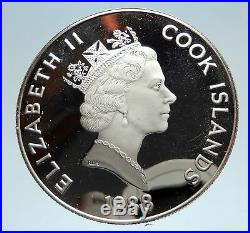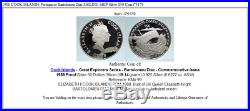1988 COOK ISLANDS Portuguese Bartolomeu Diaz SAILING SHIP Silver $50 Coin i75179
Written by admin at May 15, 2020



Item: i75179 Authentic Coin of. Great Explorers Series – Bartolomeu Diaz – Commemorative Issue 1988 Proof Silver 50 Dollars 38mm (19.14 grams) 0.925 Silver 0.6227 oz. ASW Reference: KM# 99 ELIZABETH II COOK ISLANDS RDM 1988, Bust of UK Queen Elizabeth II right. Bartolomeu Dias Portuguese: batulumew di. ; Anglicized: Bartholomew Diaz ; c. 1450 – 29 May 1500, a nobleman of the Portuguese royal household, was a Portuguese explorer. He sailed around the southernmost tip of Africa in 1488, The first to do so later on setting up the route from Europe to Asia. Bartolomeu Dias was a squire of the royal court, superintendent of the royal warehouses, and sailing-master of the man-of-war, São Cristóvão (Saint Christopher). Very little is known of his early life. King John II of Portugal appointed him, on October 10, 1486, to head an expedition to sail around the southern tip of Africa in the hope of finding a trade route to India. Dias was also charged with searching for the lands ruled by Prester John, a fabled Christian priest and ruler of a territory somewhere beyond Europe. He left 10 months later in August 1487. In the early 1480s Diogo Cão in two voyages (he died towards the end of the second) had explored the mouth of the Congo River and sailed south of the Equator to present-day Angola and Namibia. A second caravel, the São Pantaleão , was commanded by João Infante and piloted by Álvaro Martins. The expedition sailed south along the west coast of Africa. More provisions were picked up on the way at the Portuguese fortress of São Jorge de Mina on the Gold Coast. After having sailed south of modern day Angola, Dias reached the Golfo da Conceicão (Walvis Bay, in modern Namibia) by December. Continuing south, he discovered first Angra dos Ilheus, being hit, then, by a violent storm. Thirteen days later, from the open ocean, he searched the coast again to the east, discovering and using the westerlies winds – the ocean gyre, but finding just ocean. Having rounded the Cape of Good Hope at a considerable distance to the west and southwest, he turned towards the east, and taking advantage of the winds of Antarctica that blow strongly in the South Atlantic, he sailed northeast. After 30 days without seeing land, he entered what he named Aguada de São Brás (Bay of Saint Blaise)-later renamed Mossel Bay-on 4 February 1488. Dias’s expedition reached its furthest point on 12 March 1488 when they anchored at Kwaaihoek, near the mouth of the Boesmans River, where a padrão-the Padrão de São Gregório-was erected before turning back. Dias wanted to continue sailing to India, but he was forced to turn back when his crew refused to go further and the rest of the officers unanimously favoured returning to Portugal. It was only on the return voyage that he actually discovered the Cape of Good Hope, in May 1488. The discovery of the passage around southern Africa was significant because, for the first time, Europeans could trade directly with India and the Far East, bypassing the overland Euro-Asian route with its expensive European, Middle Eastern and Central Asian middlemen. The official report of the expedition has been lost. Bartolomeu Dias originally named the Cape of Good Hope the “Cape of Storms” (Cabo das Tormentas). It was later renamed (by King John II of Portugal) the Cape of Good Hope (Cabo da Boa Esperança) because it represented the opening of a route to the east. After these early attempts, the Portuguese took a decade-long break from Indian Ocean exploration. Dias only participated in the first leg of Da Gama’s voyage, until the Cape Verde Islands. Two years later he was one of the captains of the second Indian expedition, headed by Pedro Álvares Cabral. This flotilla first reached the coast of Brazil, landing there in 1500, and then continued eastwards to India. Dias perished near the Cape of Good Hope that he presciently had named Cape of Storms. Four ships encountered a huge storm off the cape and were lost, including Dias’, on 29 May 1500. The Cook Islands (Cook Islands Mori: Kki’irani) is a self-governing island country in the South Pacific Ocean in free association with New Zealand. It comprises 15 islands whose total land area is 240 square kilometres (92.7 sq mi). The Cook Islands’ Exclusive Economic Zone (EEZ) covers 1,800,000 square kilometres (690,000 sq mi) of ocean. New Zealand is responsible for the Cook Islands’ defence and foreign affairs, but they are exercised in consultation with the Cook Islands. In recent times, the Cook Islands have adopted an increasingly independent foreign policy. Although Cook Islanders are citizens of New Zealand, they have the status of Cook Islands nationals, which is not given to other New Zealand citizens. The Cook Islands’ main population centres are on the island of Rarotonga (10,572 in 2011), where there is an international airport. There is a larger population of Cook Islanders in New Zealand itself; in the 2013 census, 61,839 people said they were Cook Islanders, or of Cook Islands descent. With about 100,000 visitors travelling to the islands in the 2010-11 financial year, tourism is the country’s main industry, and the leading element of the economy, ahead of offshore banking, pearls, and marine and fruit exports. World-renowned expert numismatist, enthusiast, author and dealer in authentic ancient Greek, ancient Roman, ancient Byzantine, world coins & more. Ilya Zlobin is an independent individual who has a passion for coin collecting, research and understanding the importance of the historical context and significance all coins and objects represent. Send me a message about this and I can update your invoice should you want this method. Getting your order to you, quickly and securely is a top priority and is taken seriously here. Great care is taken in packaging and mailing every item securely and quickly. What is a certificate of authenticity and what guarantees do you give that the item is authentic? You will be very happy with what you get with the COA; a professional presentation of the coin, with all of the relevant information and a picture of the coin you saw in the listing. Additionally, the coin is inside it’s own protective coin flip (holder), with a 2×2 inch description of the coin matching the individual number on the COA. Whether your goal is to collect or give the item as a gift, coins presented like this could be more prized and valued higher than items that were not given such care and attention to. When should I leave feedback? Please don’t leave any negative feedbacks, as it happens sometimes that people rush to leave feedback before letting sufficient time for their order to arrive. The matter of fact is that any issues can be resolved, as reputation is most important to me. My goal is to provide superior products and quality of service. How and where do I learn more about collecting ancient coins? Visit the Guide on How to Use My Store. For on an overview about using my store, with additional information and links to all other parts of my store which may include educational information on topics you are looking for. The item “1988 COOK ISLANDS Portuguese Bartolomeu Diaz SAILING SHIP Silver $50 Coin i75179″ is in sale since Thursday, January 31, 2019. This item is in the category “Coins & Paper Money\Coins\ World\Australia & Oceania\Other Oceania Coins”. The seller is “highrating_lowprice” and is located in Rego Park, New York. This item can be shipped worldwide.
- Certification: Uncertified
Sorry, comments are closed for this post.